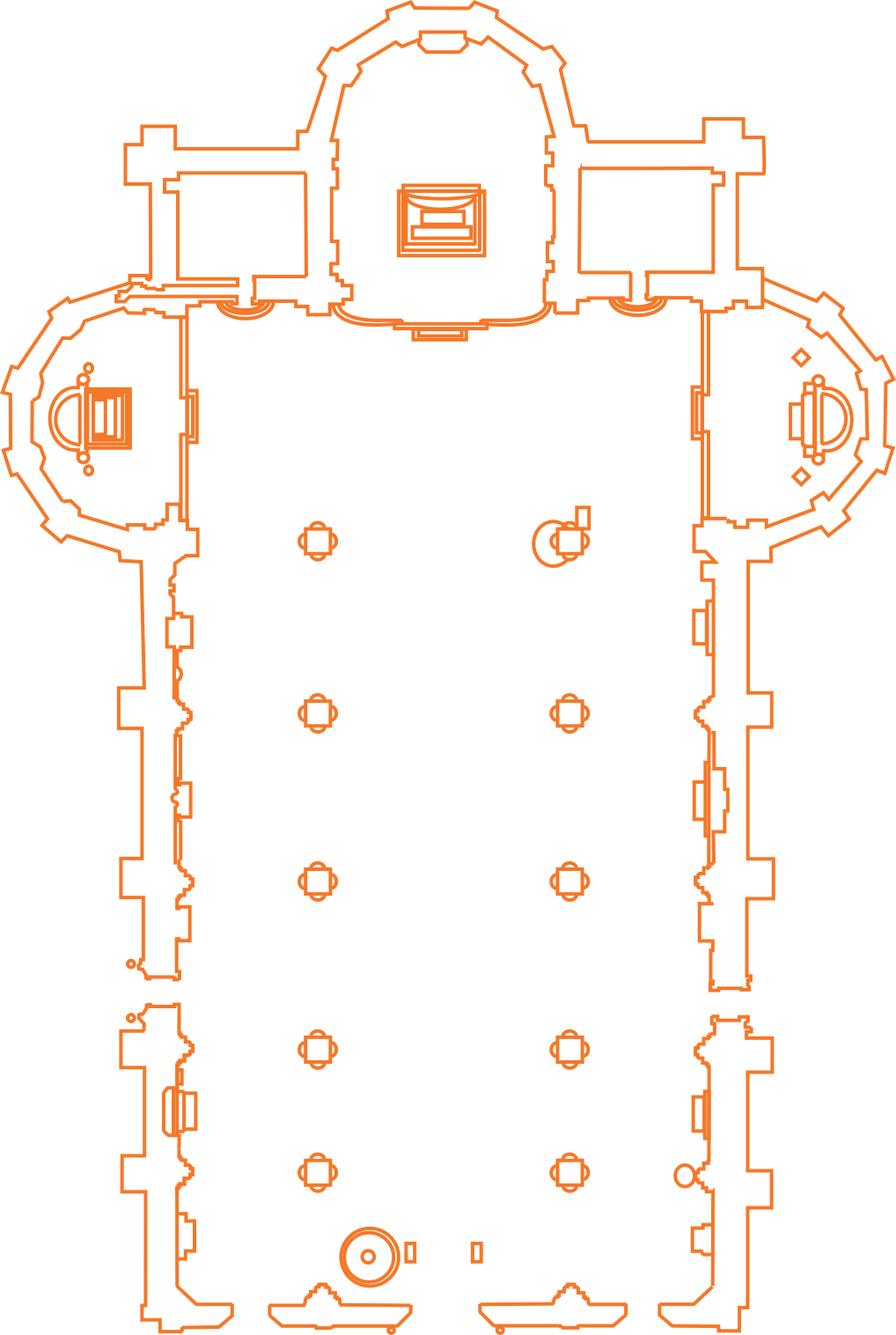Guida multimediale del Duomo di Como
Visita guidata all'interno del Duomo di Como - testi di Alberto Rovi
Campata destra 1
La prima campata meridionale è dedicata a S. Ambrogio. Il santo protettore di Milano è scolpito sulla chiave di volta. S. Ambrogio è il protagonista del polittico in pietra scolpita …
Navata maggiore 1
Nella prima campata della navata maggiore sui lati della porta stanno gli oggetti più antichi del Duomo: le sculture romaniche del leone e della leonessa. Oggi reggono i vasi dell’acqua …
Campata destra 2
Il secondo altare è detto di Santa Lucia perché vi si celebrava nella sua festa almeno dal 1627. La cappella in origine era dedicata a San Lorenzo, raffigurato nella chiave …
Campata destra 3
Il santo scolpito nella chiave di volta è l’evangelista San Matteo, che regge un libro e il cartiglio che lo identifica. La porta laterale scolpita dai Rodari reca l’iscrizione “Tempio …
Campata sinistra 1
La prima campata settentrionale è illuminata dal finestrone gotico della facciata, ma resta cieca sopra l’altare perché a ridosso dell’edificio del Broletto. La vetrata dipinta dal milanese Pompeo Bertini (1854-55) …
Navata maggiore 2
La seconda campata è dedicata al figlio di Abramo, Isacco, raffigurato a rilievo e dipinto nella serraglia della volta (fine XV sec.) . Sui piloni gli Apostoli scolpiti da Tommaso …
Navata maggiore 3
La terza campata centrale è dedicata a Giacobbe, raffigurato a rilievo dipinto nella serraglia della volta (fine XV sec.). Le statue degli apostoli S. Simone a nord e S. Giacomo …
Navata maggiore 4
Nelle prime campate della navata maggiore al centro della volta la serraglia presenta un profeta: qui c’è soltanto una croce bianca in campo rosso. È lo stemma del Comune di …
Campata destra 4
La cappella è dedicata a S. Andrea raffigurato nella chiave di volta. L’altare è dedicato a S. Abbondio. La grande ancona in legno scolpito dirato e dipinto è un capolavoro …
Navata maggiore 5
Nella chiave di volta è scolpita S. Lucia . In alto sul pilone a sinistra sotto la cupola si legge la data “MDCII”, 1602, quando fu riadattato in previsione dell’erezione …
Campata destra 5
La cappella era dedicata a San Tommaso Apostolo, raffigurato nella chiave di volta. La quinta campata contiene diverse opere d’arte: la pala d’altare di Bernardino Luini ; due quadri con …
Cappella maggiore
Le linee architettoniche dell’abside centrale realizzano il progetto rinascimentale che iniziò proprio da quest’abside, costruita nel corso di tutto il Cinquecento, prima delle due identiche absidi laterali all’estremità del transetto, …
Cappella della Madonna
La Cappella nell’abside meridionale è dedicata alla Beata Vergine Assunta La costruzione della cappella meridionale iniziò nel 1627 su modello rinascimentale dell’abside centrale. Diresse i lavori l’architetto milanese Francesco Maria …
Cappella del Crocifisso
La Cappella del Crocifisso è di architettura identica a quella delle due precedenti absidi. La costruzione fu diretta da Carlo Buzzi ingegnere del Duomo di Milano dal 1653. Il luogo …
La cupola
La grandiosa cupola , costruita a partire dal 1733, fu progettata da Filippo Juvarra (1730), allora architetto di Casa Savoia. Con la sua altezza costituisce il fulcro visuale della città …
Campata sinistra 5
Nella chiave di volta è scolpito l’Agnello mistico , emblema del sacrificio di Cristo ed attributo iconografico di S. Giovanni Battista cui la cappella è dedicata insieme a S. Nicola. …
Campata sinistra 4
La quarta campata era anticamente dedicata alla Crocefissione. Dal primo ‘800 è dedicata a San Giuseppe. L’altare fu completamente rifatto dal 1830 su disegno dell’arch. Giacomo Moraglia. È opera di …
Campata sinistra 3
La porta settentrionale è detta Porta della rana per un particolare scolpito all’esterno. È datata 1507 e decorata a rilievo anche all’interno dove si trovano le firme di Tommaso e …
Campata sinistra 2
La seconda campata è dedicata a S. Stefano protomartire: S. Stefano è raffigurato a rilievo dipinto e a mezzo busto nella chiave di volta. L’ancona d’altare in marmo fu scolpita …
